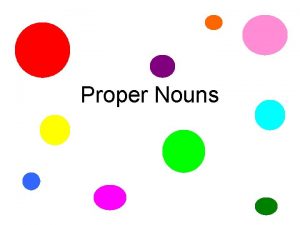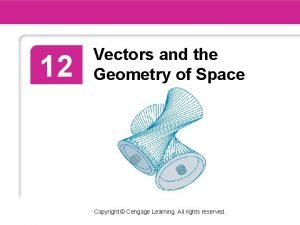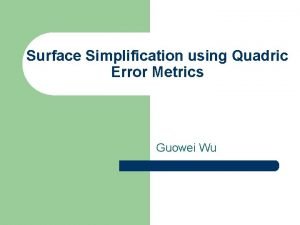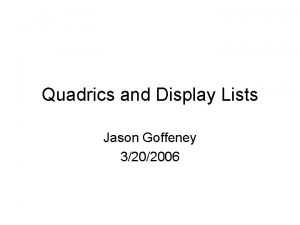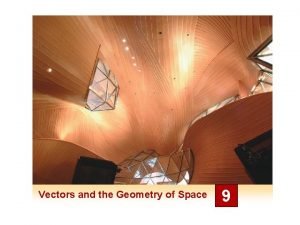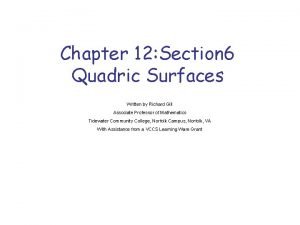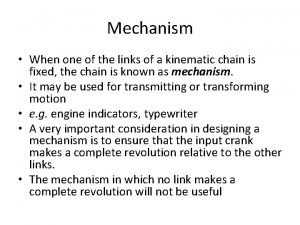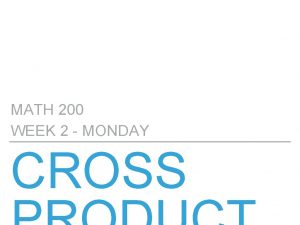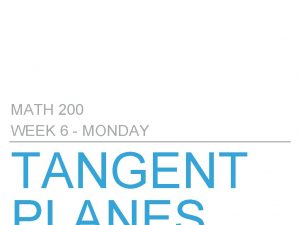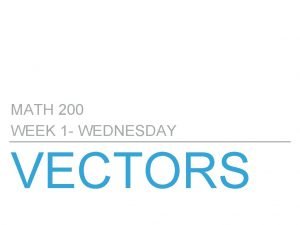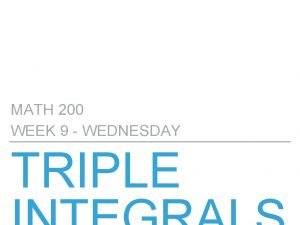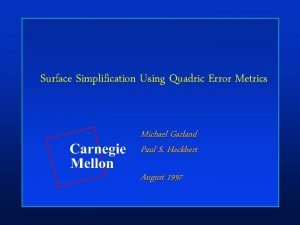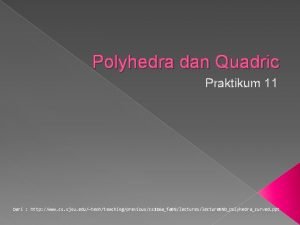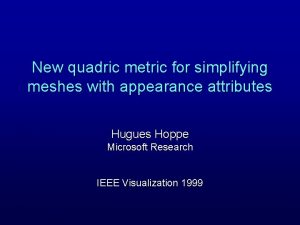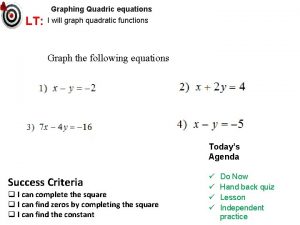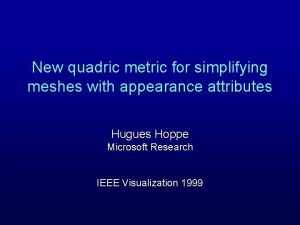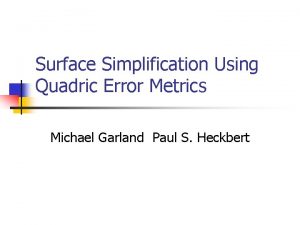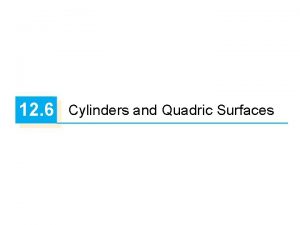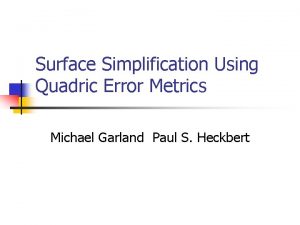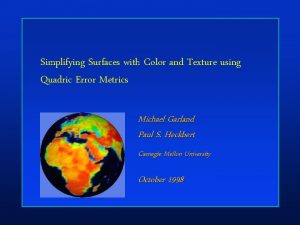MATH 200 WEEK 3 FRIDAY QUADRIC MATH 200


















- Slides: 18

MATH 200 WEEK 3 - FRIDAY QUADRIC

MATH 200 MAIN QUESTIONS FOR TODAY ▸ What are some of the main quadric surfaces? ▸ How do we distinguish between the various quadric surfaces? ▸ What is a trace? ▸ Given an equation in x, y, and z, how do we use traces to determine what the surface corresponding to the equation looks like?

MATH 200 QUADRIC SURFACES ▸ Surfaces that result from equations of the form ▸ Examples:

MATH 200 TRACES ▸ To figure out what these look like, we’ll start by looking at traces. ▸ A trace of a surface is the intersection of the surface with a given plane ▸ This will be a curve, a point, or nothing ▸ Putting traces together, we’ll deduce what the whole surface looks like ▸ Often, traces on planes like x=0, 1, 2, 3, …, y=0, 1, 2, 3…, and z=0, 1, 2, 3… will be enough

MATH 200 EXAMPLE 1 ▸ Let’s start with z = x 2 + y 2 ▸ Let’s look at the traces on the planes z = 0, z = 1, z = 2, … ▸ z = 0: x 2 + y 2 = 0 ▸ the only solution is the point (0, 0) ▸ z = 1: x 2 + y 2 = 1 ▸ unit circle ▸ z = 2: x 2 + y 2 = 2 ▸ circle with radius sqrt(2)

MATH 200 ▸ Now, let’s look at traces on the planes x=0, 1, -1 ▸ x=0: z = y 2 ▸ This is a parabola on the yz-plane ▸ x=1: z = 1 + y 2 ▸ This is a parabola shifted up on the yz-plane ▸ x=-1: z = 1 + y 2 ▸ This is a parabola shifted up on the yz-plane

MATH 200 ▸ Now, let’s look at traces on the planes y=0, 1, -1 ▸ y=0: z = x 2 ▸ This is a parabola on the xz-plane ▸ y=1: z = x 2+1 ▸ This is a parabola shifted up on the xz-plane ▸ y=-1: z = x 2+1 ▸ This is a parabola shifted up on the xz-plane

MATH 200 ▸ Alright, now to put it all together… ▸ First, we’ll draw our traces for z=0, 1, 2 ▸ Then, let’s add in the ones for x=0, y=0 ▸ The shape is coming together… ▸ Here are the rest of the traces

MATH 200 EXAMPLE 2 ▸ Let’s repeat the same process for z 2 = x 2 + y 2 ▸ Draw traces by setting x, y, and z equal to various constant values (e. g. -1, 1, 0, 1, 1) ▸ First draw those traces in 2 D ▸ Then combine them into a 3 D sketch ▸ With a few traces in each “direction” you should be able to deduce the shape…

MATH 200 ▸ Traces ▸ z = constant ▸ z = 0: 0 = x 2+y 2 (only a point (0, 0)) ▸ z = -1, 1 both give the same trace: 1 = x 2+y 2 (unit circle) ▸ x = constant ▸ x=0: z 2 = y 2, which is the same as |z| = |y| ▸ x = -1, 1 both give the same trace: z 2 = 1+y 2 (hyperbola) ▸ y = constant ▸ y=0: z 2 = x 2, which is the same as |z| = |x| ▸ y = -1, 1 both give the same trace: z 2 = x 2 + 1 (hyperbola)

MATH 200 ▸ We’ll start with the first few traces and see what we see ▸ Already we can see that it’s going to be a double cone ▸ With too many traces drawn at once it can be tricky to visualize, but here’s what they look like on the surface

MATH 200 CLARIFYING A LITTLE BIT ▸ We found the trace for y=1 in the last example to be the hyperbola z 2=x 2+1 ▸ In 2 D, it looks like this ▸ This is really on the plane y=1, so isolating that curve in 3 D looks like this

MATH 200 EXAMPLE 3 ▸ Looking at z 2=x 2+y 2+1, we can tell one thing right away about the possible z-values… ▸ x 2+y 2+1 ≥ 1 which means z 2≥ 1 ▸ …which means z≤-1 and z≥ 1 ▸ …which means there’s an empty space between -1 and 1 in the z-direction ▸ Draw some traces for (valid) constant values of z ▸ Draw traces for x=0 and y=0 ▸ See if that’s enough…

MATH 200 ▸ With a few z traces and the x=0 and y=0 traces, we get a good sense of the shape ▸ When z=const. we get circles. ▸ When x=0 or y=0 we get hyperbolas ▸ We call this shape a hyperboloid of two sheets

MATH 200 EXAMPLE 4 HYPERBOLOID OF ONE SHEET ▸ In the last example (z 2=x 2+y 2+1) we notice that we couldn’t get z-values between -1 and 1 ▸ How is z 2=x 2+y 2 -1 different? ▸ Writing it like this might help: z 2+1=x 2+y 2 ▸ In this case, x 2+y 2≥ 1, so inside the unit circle/cylinder is empty. ▸ The traces are still circles and hyperbolas

MATH 200 ▸ If z = constant, we get circles ▸ (k 2+1)=x 2+y 2 ▸ If x or y are constant, we get hyperbolas ▸ z 2+1=k 2+y 2 ▸ z 2+1=x 2+k 2 ▸ In combination, we get a hyperboloid of one sheet

MATH 200 LASTLY…THE HYPERBOLIC PARABOLOID - AKA THE SADDLE ▸ z = y 2 - x 2 ▸ Hyperbolas for z = constant (except zero) ▸ z = 0: |x| = |y| ▸ z = 1: y 2 = x 2+1 ▸ z = -1: x 2 = y 2+1 ▸ Parabolas in opposite directions for x=const. and y=const. ▸ x=0: z = y 2 ▸ y=0: z = -x 2

MATH 200
 Proper noun name of person
Proper noun name of person 100 + 200 + 300
100 + 200 + 300 Quadric surfaces chart
Quadric surfaces chart Guowei wu
Guowei wu Gluquadric
Gluquadric Quadric surfaces
Quadric surfaces Yz plane equation
Yz plane equation Watt indicator mechanism is an inversion of
Watt indicator mechanism is an inversion of Week by week plans for documenting children's development
Week by week plans for documenting children's development When……..you finish your homework ?
When……..you finish your homework ? 200 + 200 + 300
200 + 200 + 300 200+200+100+100
200+200+100+100 200+200+300+300
200+200+300+300 100 + 100 200
100 + 100 200 200+400+600
200+400+600 300 + 200 + 200
300 + 200 + 200 How was your last weekend answer
How was your last weekend answer Sinful friday
Sinful friday Friday the 13th igg
Friday the 13th igg
